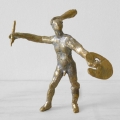Galleri Flach has the pleasure of hosting the exhibition Lost Wax with the artist Fredrik Wretman, nearly ten years after his last exhibition at the gallery, “Minitrans” in 2003, when the gallery was still on Skeppargatan in Stockholm. Since then, Fredrik Wretman has been engaged in a constant flow of public and private commissions, for galleries, museums and other art spaces. He is now showing a completely new series of sculptures – a number of multifaceted, playful bronzes – highlighting yet another dimension of an already rich and diverse oeuvre.
Although Fredrik Wretman has long been at the forefront of developments in new artistic media, he has always maintained a distinct relationship to the craftsmanship of art. For the exhibition Lost Wax, he has modelled an extensive series of imaginative, fable-like creatures that have been cast in bronze. They appear to belong in a surrealist landscape or a commedia dell’arte troupe. Even though they are small enough to hold in one hand, they have a poignant character that radiates strongly from their various positions in the room, with expressive poses and formations. Wretman describes how the figures arose in an unconscious, pleasurable and intuitive process that, for the first time in a long while, was not focused on any particular assignment or given context.
Those of us who have followed Wretman’s career will have taken part in a voyage that has included magnificent water installations with mirror-like surfaces, small, smart and thought-provoking figures, videos and projections and meditative architectonic spaces where various media blend to create suggestive totalities.
The small bronze figures in this exhibition do not claim much space, but each one separately delivers its own history in the narrative form of a classical allegory. Their art historical resonance is reminiscent of sculptors such as Tobias Sergel, but there is an even more definite link to Jackson Pollock. It is all about wanting to create some space, and refraining from fulfilling conventional requirements. In our contemporary world, it may seem totally crazy that this striving should be expressed in small bronze dragons and other figures with eyes made of diamonds. But is also an intriguing sign of the times.







